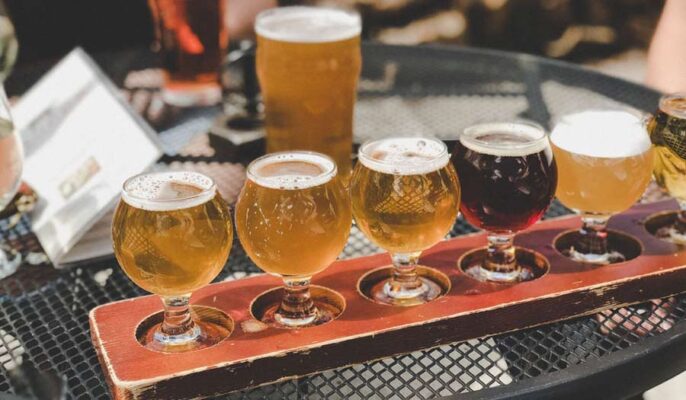Every beer is made up of complex flavors that everyone perceives . There are a lot of off-flavors in beer, but there are only a few very common ones. Most off-flavors in beer are occurring. Some are even required in certain beers, and some are actually features of specialty styles. Some craft beers can produce excessive alcohol flavors and aromas. In this article, we’ll explore the root causes of alcoholic odors.
Cause and control
The cause and control of flavor go hand in hand. Once you understand the cause of flavors in your beer, you can better manage your brew day and beer handling to control or cut the cause. Brewers should consider and explain the reasons for different flavors. not in detail, but at least in the big picture.
Some odors, especially those caused by contamination, are almost always considered defective. Despite the occasional wild yeast contamination epiphany that makes something beautiful. These odors are usually caused by poor hygiene and, less often, improper brewing methods.
Any off-flavors not caused by contamination are always caused by your brewing practices, such as uncontrolled fermentation temperatures, waiting too long for secondary fermentation, inadequate boiling, poor bottling technique, or choosing the wrong yeast.

Why does craft beer have too much alcohol?
When brewers refer to alcohol without any other qualification, we are talking about ethanol (CH3CH2OH), which is the primary alcohol by-product of yeast fermentation. But that’s not the only thing about alcohol. Alcohol is the general term for any organic compound with a free hydroxyl group (-OH). Other alcohols that may occur during fermentation include so-called fuse alcohols:
- Isoamyl alcohol
- Propanol
- Isobutanol
- Butanol
This fusel alcohol is present in various fermentation processes to varying degrees. But when it comes to making great craft beers, their concentrations are well below the threshold for human perception. Our palate is generally more sensitive to this type of alcohol (fusel alcohol) than to pure ethanol.
What are the factors that affect fusel alcohols?
Higher order fusel alcohols
During normal fermentation, yeast cells consume sugar and produce alcohol (ethanol) as a by-product. But, as fermentation temperature increases, yeast tends to produce more fusel alcohols. These higher alcohols create the warm, moonshine flavors that are undesirable in craft beers.
Thus, the main reason for the formation of fusel alcohol is that the yeast fermentation temperature is too high. To avoid them, you need to manage fermentation temperatures. In an ideal fermentation environment, you want to keep the internal temperature of the fermenter within the recommended range of the yeast used for brewing.
Proper gravity and malt balance
The second reason for high alcohol content is proper malt balance and starting gravity. Because the initial specific gravity and alcohol content of wort are very high, excessive alcohol content is common in beers with very high specific gravity (such as highland barley wine). If you are using a high gravity beer and the alcohol content is too high, consider brewing with a lower starting gravity to reduce the final toast content. Additionally, you need to ensure a proper malt-hop balance, as high-gravity beers must enough hops to offset the malt used.
Extend the time of yeast contact
Fusel alcohols are also produced when we extend the contact time between beer and yeast, but this time is measured over months, not weeks. If you tend to store your beer for a month or more before packaging, you don’t have to worry about fusel alcohols.

How to reduce the fusel alcohol content in beer?
Fusel alcohols are one of the main components of beer flavor. If the fusel alcohol content in the beer is too low, the beer lacks the characteristic beer flavor. If the fusel alcohol content in beer is too high, drinkers may experience headaches after drinking it. So, as a brewer, it’s important to get the right fusel alcohol content.
- Choose yeasts that produce low concentrations of fusel alcohols. It is well known that fusel alcohols are metabolites of Saccharomyces cerevisiae. Selecting yeast with low fusel alcohol content is the main means to reduce the fusel alcohol content in beer.
- Choose the correct yeast propagation method. Too to increasing the number of yeast, yeast expansion must also improve the activity of the yeast and its ability to adapt to the environment.
- Add appropriate amount of yeast. Adding too much yeast will lead to too fast fermentation and an increase in fermentation metabolites.
- Proper wort oxidation. The brewer needs to increase the amount of dissolved oxygen in the yeast, neither making the yeast too active nor making the yeast too weak.
- Reduce the pH of wort. The pH of the wort is controlled at around 5.4 through acid change technology, and the saccharification time is shortened as much as possible to reduce the dissolution of buffer substances in the wort.
- Choose the appropriate fermentation temperature. Generally speaking, the higher the fermentation temperature, the more fusel alcohols are produced.
- Increase the pressure in the fermentation tank. When fermentor pressure increases, yeast activity is inhibited and metabolites are reduced.
- Early recovery of yeast is also an important means to reduce fusel alcohols.
- Reduce oxygen intake in beer. During the beer filtration and filling processes, inhaling oxygen will increase aldehydes, leading to an increase in fusel alcohols in the beer.




